Study of Petrogenesis and Tectonomagmatic Environments of Eocene Calc-Alkaline Volcanic Units in South and Southeast of Beroni Village in Southwest Ardestan (Isfahan)
Sayyed Hossein Roshan1 * and Ali Khan Nasr Esfahani2
1
Department of Geology,
Isfahan (Khorasgan) Branch,
Islamic Azad University,
Isfahan,
Iran
2
Department of Geology,
Isfahan (Khorasgan) Branch,
Islamic Azad University,
Isfahan,
Iran
DOI: http://dx.doi.org/10.12944/CWE.10.Special-Issue1.86
The study area is located in south and southeast of Beroni Village. It contains volcanic rocks including andesitic-basaltic, pyroxene-bearing andesite, andesite, dacite, rhyodacite, rhyolites and Eocene-Oligocene ignimbrites. The volcanic rocks are cut by an intrusive mass with great spreading in the region. According to lithological studies, the calc-alkaline magmas in continental margin arcs are comprised of mantle and fluid crust. The basic elements in the volcanic rocks were studied in terms of petrological indices. According to the results, the metaluminous rocks underwent crustal contamination. Due to chemical reactions between the hydrothermal solution and volcanic host rocks, hydrothermal solutions in volcanic rocks penetrate the surrounding silica rocks and thus some elements such as zinc and barium diffuse in the rocks. In addition, calcium, magnesium and iron have been drawn inwards from the surrounding rocks causing lateral segregation.
Copy the following to cite this article:
Roshan S. H, Esfahani A. K. N. Study of Petrogenesis and Tectonomagmatic Environments of Eocene Calc-Alkaline Volcanic Units in South and Southeast of Beroni Village in Southwest Ardestan (Isfahan). Special Issue of Curr World Environ 2015;10(Special Issue May 2015). DOI:http://dx.doi.org/10.12944/CWE.10.Special-Issue1.86
Copy the following to cite this URL:
Roshan S. H, Esfahani A. K. N. Study of Petrogenesis and Tectonomagmatic Environments of Eocene Calc-Alkaline Volcanic Units in South and Southeast of Beroni Village in Southwest Ardestan (Isfahan). Special Issue of Curr World Environ 2015;10(Special Issue May 2015).
Available from: http://cwejournal.org?p=684/
Download article (pdf) Citation Manager Publish History
Select type of program for download
| Endnote EndNote format (Mac & Win) | |
| Reference Manager Ris format (Win only) | |
| Procite Ris format (Win only) | |
| Medlars Format | |
| RefWorks Format RefWorks format (Mac & Win) | |
| BibTex Format BibTex format (Mac & Win) |
Article Publishing History
| Received: | 2015-03-21 |
|---|---|
| Accepted: | 2015-03-25 |
Introduction
The study area is located at initial longitude of 52Ëš 17’ 56’', terminal longitude of 52Ëš 20’ 21”, initial latitude of 33Ëš 14’ 11” and terminal latitude of 33Ëš 15’ 33” in south and southeast of Beroni Village in southwest Ardestan and northeast Isfahan (] Eftekharnezhad,1980)( Shahabpour,2005) (Figures 1-3). Ardestan is located in northeast of Isfahan and south of Kavir-e Namak at an altitude of 1252 m above sea level with a surface area of 18077.06 km2. Ardestan is bounded on north by Kavir-e Namak while there are several mountain ranges in south Ardestan. Precambrian and Paleozoic sediments have not been observed in the region. The oldest sediments belong to Triassic period. There are Jurassic and Cretaceous outcrops in southwest and west Ardestan (Radfar,1997).
There are different theories on volcanism in this zone. There are andesitic-basaltic, pyroxene-bearing andesite, andesite, dacite, rhyodacite, rhyolitic es and ignimbritic volcanic rocks in the region. Volcanic activity in the region reached its peak in the upper middle Eocene. Lava tracks were rhyodacite in the early stages and then were converted into dacite-andesitic, andesite, pyroxene-bearing andesite and basaltic andesite rocks (Aghanabati,2006). Andesites are of great importance in terms of volume and there are dacite-ignimbrite rocks in the base. Oligocene-Miocene lavas are mainly seen as rhyolitic domes in the region (Radfar,1997).
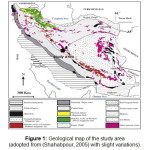 |
Figure 1: Geological map of the study area (adopted from (Shahabpour, 2005) with slight variations). Click here to View figure |
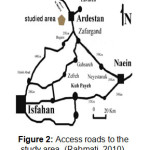 |
Figure 2: Access roads to the study area (Rahmati, 2010). Click here to View figure |
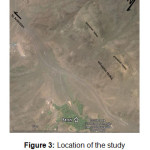 |
Figure 3: Location of the study area on the Google Map (2014). Click here to View figure |
Materials and Methods
The study area was visited in June 2013 and 35 samples were collected from selected stations. Intact unaltered samples (6 unaltered and 3 severely altered) were selected to study unaltered volcanic host rock. This will lead to higher accuracy of mineralogical and geochemical studies. Samples were also taken from alteration horizons. In all steps, formations in the region were also photographed.
Thirty five thin sections were prepared from all samples. The thin sections were studied in the Laboratory of Geology, Islamic Azad University, Isfahan (Khorasgan) Branch using a polarizing binocular microscope (Nikon). The type of minerals, their relationship, rock texture and alteration types were investigated. Eight rock samples from exterior igneous outcrops were prepared for chemical analysis by ICP-OES in Kimia Pazhoh Research Laboratory affiliated to Science and Research Town of Isfahan University of Technology (the results of all chemical analyses can be provide by the authors).
Then, the field, petrographic and geochemical and geological data were combined to simulate the geological and magmatic history of the study area. Data analysis and norm calculation were performed with the help of Minpet, Igpet and SPSS. Finally, the results of chemical analysis and field and petrographic studies were used to determine the magmatic series and tectonic environment as well as data analysis and interpretation.
Results and Discussion
General Geology of the Study Area
Ardestan is a part of the volcano-sedimentary belt of Orumieh-Dokhtar with Eocene and Oligocene volcanic and intrusive rocks. Low-height Eocene rhyolitic domes have a negligible spreading in the region. It seems that the main volcanic activities in this area have been started from middle Eocene. Therefore, the rocks in the region have been formed by volcanic activities in upper middle Eocene(Darvishzadeh,1991) (MoeinVaziri). Eocene volcanic rocks cross the intrusive mass in the region. According to the contact with surrounding volcanic rocks and regional tectonic phases, it may belong to post-Eocene period (Radfar,1997).
Classification of Rocks
The use of silica in classification of igneous rocks is very important for chemical classification of volcanic rocks, because silica is the main oxide in magmatic rocks. The concentration of molten silica controls its physical and structural properties. In addition, Na2O and K2O levels are important ​​in silica calculations.8 Magmatic rocks can be divided into sub-alkaline, alkaline and hyperalkaline rocks. The level of Na2O, SiO2 and K2O usually determines the level and type of felsic minerals in a rock. Among the oxides, CaO, Al2O3 and MgO are of secondary importance for determining modal and chemical parameters (Cox et al.,1979).
Placement of the samples on volcanic rock chart is determined using total alkali versus silica (Cox et al.,1979).. The volcanic and pyroclastic rocks are of andesitic type (Figure 4). This chart is one of the most comprehensive graphs for classification of volcanic rocks which has been approved by many geologists (Rollinson,1993). As can be seen, severely altered samples (dacite and tholeiitic) are located in other regions because of alteration.
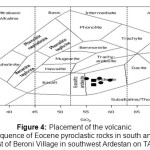 |
Figure 4: Placement of the volcanic sequence of Eocene pyroclastic rocks in south and southeast of Beroni Village in southwest Ardestan on TAS chart. Click here to View figure |
Sub-alkaline volcanic rock series have been classified into calc-alkaline rocks with low, moderate and high potassium content, low-K tholeiitic and alkaline (shoshonite) rocks. One of the classifications is presented in (Peccerillo et al.,1976). According to the chart, the calc-alkaline samples belong to sub-alkaline series (Figure 5).
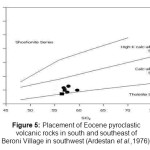 |
Figure 5: Placement of Eocene pyroclastic volcanic rocks in south and southeast of Beroni Village in southwest (Ardestan et al.,1976). Click here to View figure |
Classification of Rocks Based on Aluminum and Potassium Indices
In A/CNK-A/NK diagram (classification based on the saturation degree of aluminum, Al2O3), the rocks are divided into peraluminous, metaluminous and peralkaline rocks. Aluminum index has been presented in (Debon et al.,1983)based on cations (Figure 6). Placement of samples on the chart given in(Shand et al.,1943) shows that the rocks in the region are of metaluminous type.
![Figure 6: Placement of Eocene pyroclastic volcanic rocks in south and southeast of Beroni Village in southwest Ardestan on the chart [12], A/NK=Al2O3 (Na2O + K2O), A/CNK=Al2O3/ (CaO + Na2O + K2O).](http://www.cwejournal.org/wp-content/uploads/2015/05/Vol10_Spe_Study_Sayye_Fig6-150x150.jpg) |
Figure 6: Placement of Eocene pyroclastic volcanic rocks in south and southeast of Beroni Village in southwest Ardestan on the chart [12], A/NK=Al2O3 (Na2O + K2O), A/CNK=Al2O3/ (CaO + Na2O + K2O). Click here to View figure |
Tectonomagmatic Environments (Condie, 1989)
A suitable chart discriminating tectonic environments should be specified with elements insensitive to secondary processes. In addition, the elements should be measured by relatively simple and rapid analysis methods with high precision even at low concentrations (] Rollinson,1993). It is important to know the rate of crystallization to use the charts. Since the rocks are somewhat weathered and altered, the efficiency of charts used basic elements is low. Thus, elements with limited mobility (e.g. Rb, Hf, Zr, Nb, Ti) should be used for altered rocks. One of the charts is Th/Yb versus La/Yb . According to placement of samples on the chart, the samples are located within continental margin arcs (Figure 7).
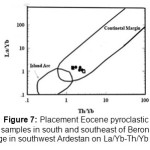 |
Figure 7: Placement Eocene pyroclastic samples in south and southeast of Beroni Village in southwest Ardestan on La/Yb-Th/Yb chart. Click here to View figure |
Depletion and Enrichment Charts
To plot depletion and enrichment charts, the maximum altered silicic sample (Sample No. B1s11) was normalized relative to less altered sample (Sample No. B1s5). The chart shows enrichment of Zn, Ba and Cs and depletion of Sr and Li (Figure 8). This reflects displacement of various elements during alteration.
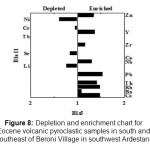 |
Figure 8: Depletion and enrichment chart for Eocene volcanic pyroclastic samples in south and southeast of Beroni Village in southwest Ardestan. Click here to View figure |
Changes in Elements
The chemical changes around alteration zone were investigated based on the changes on elements and oxides. The results are presented below.
Distribution of major oxides such as SiO2 around the alteration zone indicates addition of silica veins into inclusive rocks due to silicification of rocks in alteration zones. The major oxides, Al2O3 and CaO are depleted around the alteration zone indicating a change in the composition of minerals from primary minerals to altered minerals (Figure 9). Oxides such as Fe2O3 and MgO have been decreased around the alteration zone (Figure 10). However, zinc and barium are enriched (Figure 11). Generally, SI and CIA show enrichment (Figure 12) while CCPI and AI show depletion (Figure 13).
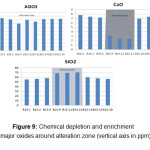 |
Figure 9: Chemical depletion and enrichment of major oxides around alteration zone (vertical axis in ppm). Click here to View figure |
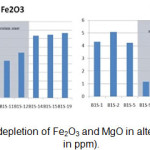 |
Figure 10: Chemical depletion of Fe2O3 and MgO in alteration zone (vertical axis in ppm). Click here to View figure |
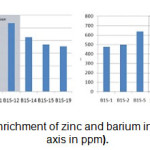 |
Figure11: Chemical enrichment of zinc and barium in alteration zone (vertical axis in ppm). Click here to View figure |
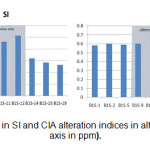 |
Figure 12: Changes in SI and CIA alteration indices in alteration zone (vertical axis in ppm). Click here to View figure |
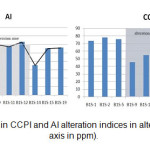 |
Figure 13: Changes in CCPI and AI alteration indices in alteration zone (vertical axis in ppm). Click here to View figure |
Conclusion
According to studies on volcanic rocks in south and southeast of Beroni Village, the following results were obtained:
The Eocene volcanic rocks consist mainly of andesite basalt and andesite rocks. Pyroclastic rocks such as tuff are also observed in the region. According to lithological studies, volcanism mainly consists of ​​ andesitic tuff lavas. The tuff rocks contain quartz, plagioclase and hornblende phenocrysts and a little amount of pyroxene in magma composed of plagioclase and other minerals. The magma is composed of mantle and fluid crust. Molten fluid may be formed by intrusive sedimentary rocks or by direct reaction and digestion of continental crustal rocks. Hydrothermal solutions in volcanic rocks penetrate the surrounding silica rocks and thus some elements such as zinc and barium diffuse in the rocks. In addition, calcium, magnesium and iron have been drawn inwards from the surrounding rocks causing lateral segregation.
According to geochemical data as well as charts for rare and rare earth elements, the volcanic rocks in the region are of calc-alkaline type in sub-alkaline series. Volcanic rocks are similar to magmas in subduction and volcanic arc zones indicating enriched rare elements. The study of main elements revealed that the metaluminous rocks underwent crustal contamination. The rare elements in the volcanic rocks revealed tectonic environments of volcanic arcs. Hydrothermal alteration processes in the study area caused displacement and transport of elements. These changes are associated with mineral alteration.
References
- Eftekharnezhad, J. (1980). “Separating different parts of Iran in terms of structural conditions of sedimentary basins”, Petroleum Association Journal, 82, 19-28.
- Shahabpour, J. (2005). “Tectonic evolution of the orogenic belt in the region located between Kerman and Neyriz ”, Journal of Asian Earth Sciences, 24, 405-417.
- Rahmati, S. (2010). “Petrology and mineralogy of granitoid mass in Marbin (South ARDESTAN)”. Petrology MSc Thesis. Islamic Azad University, Khorasgan Branch, p. 93.
- Radfar, J. (1997). “1: 100,000 geological map of Tehran”, Geological and Mineral Exploration Organization Press.
- Aghanabati, A. (2006). “Geology of Iran”, Geological and Mineral Exploration Organization Press, 586 pages.
- Darvishzadeh, A. (1991). “Geology of Iran”, Danesh Emrooz Publication, 901 pages.
- MoeinVaziri, H. (1996). “Introduction to magmatism in Iran”, Tarbiat Moallem University Press, 440 pages.
- Cox, K. G, Bell, J. D., Pankhurst, R. J. (1979). “The interpretation of igneous rocks”. George, Allen and Unwin, 45p.
- Rollinson H. R. (1993). “Using geochemical data”: Evaluation, Presentation, Interpretation, Addison Wesley Logman, Harlow, 352 p.
- Peccerillo A., Tylor, S. R. (1976). “Rare earth elements in the East Carpathian volcanic rocks”: Earth and Planetary Science Letters, 32, 121-126.
- Debon, F., Le Fort, P. (1983). “A chemical – mineralogical classification of common plutonic rocks and associations”, R. Soc. EdinTrans, 73, 135 – 149.
- Shand, S. J. (1943). “The study of rocks” .London: Thomas Murby and Co. Publishing, 236 p.
- Condie, K.C. (1989). “Geochemical changes in basalts and andesites across the Archean-Proterozoic boundary”: identification and significance, Journal of Lith, 23, 1-18.







